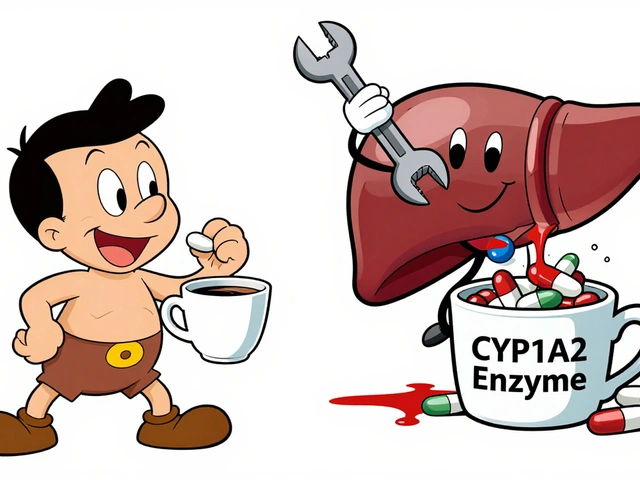
Eye Steroid Selection Tool
Choose Your Eye Steroid
This tool helps you select the most appropriate eye steroid based on your specific situation. Enter your clinical criteria to receive personalized recommendations.
Recommended Options
Eye inflammation can be painful, blurry, and even threaten vision if not managed properly. Pred Forte is a prescription‑only corticosteroid eye drop that many eye doctors reach for first. But it isn’t the only option on the market, and choosing the right product depends on potency, side‑effect risk, and how often you need to apply the drops. This guide walks you through what Pred Forte actually is, which alternatives exist, and how to decide which one fits your situation.
Key Takeaways
- Pred Forte contains 1% prednisolone acetate, a high‑potency steroid used for acute inflammation.
- Lower‑potency alternatives like loteprednol etabonate reduce the risk of eye‑pressure spikes.
- Choosing an eye steroid should balance inflammation control with the chance of ocular hypertension.
- Long‑term steroid use often requires regular intraocular pressure (IOP) monitoring.
- NSAID eye drops can serve as steroid‑sparing agents for mild to moderate inflammation.
What Is Pred Forte?
Pred Forte is a branded formulation of prednisolone acetate 1% ophthalmic suspension. It belongs to the corticosteroid class, which mimics the body’s own anti‑inflammatory hormones. When you instill the drops, the drug penetrates the cornea and reaches the anterior chamber, where it dampens the release of inflammatory mediators like prostaglandins and cytokines.
Typical indications include postoperative inflammation after cataract surgery, uveitis, severe allergic conjunctivitis, and ocular surface disease that hasn’t responded to milder agents. Because it’s a high‑potency steroid, doctors often prescribe it for short bursts (usually 1‑2 weeks) and taper it off to avoid side effects.

Common Alternatives to Pred Forte
Not everyone needs the strength of prednisolone. Below are the most frequently prescribed alternatives, each with a unique balance of potency and safety.
- Dexamethasone (e.g., Maxidex) - a very potent steroid, similar to prednisolone but with a slightly longer half‑life. Used for aggressive uveitis or postoperative inflammation when rapid control is essential.
- Loteprednol etabonate (Lotemax) - a low‑to‑moderate potency steroid designed to be metabolized quickly by ocular tissues, reducing the risk of IOP rise.
- Fluorometholone (FML) - a mid‑potency steroid often chosen for patients who need longer‑term treatment but are prone to pressure spikes.
- Rimexolone (Vexol) - another mid‑potency option with a relatively favorable safety profile, especially for allergic conjunctivitis.
- NSAID eye drops (e.g., ketorolac, nepafenac) - not steroids, but effective for mild to moderate inflammation and can be combined with low‑dose steroids to spare overall steroid exposure.
Choosing among these depends on three main factors: how strong the inflammation is, how sensitive the patient is to pressure changes, and how long the treatment is expected to last.
How to Choose the Right Eye Steroid
Here’s a quick decision framework you can run through with your eye care provider.
- Assess inflammation severity. High‑grade uveitis or post‑surgical swelling usually warrants a high‑potency drug like Pred Forte or dexamethasone.
- Check baseline intraocular pressure. If you already have borderline IOP or a family history of glaucoma, lean toward low‑potency options such as loteprednol.
- Determine treatment length. For chronic conditions, a steroid‑sparing regimen (NSAIDs plus occasional low‑dose steroid) minimizes risk.
- Consider patient compliance. Some drops require twice‑daily dosing, while others can be once‑daily; fewer doses often improve adherence.
- Review any known drug allergies. Although rare, hypersensitivity to a specific steroid ester can occur; patch testing may be advisable.
By mapping your clinical picture onto these criteria, you can select the most appropriate agent and avoid unnecessary side effects.

Side‑Effect Profile Comparison
| Drug | Potency | Typical Use | Risk of IOP Rise | Duration of Action |
|---|---|---|---|---|
| Pred Forte | High | Post‑op, severe uveitis | Medium‑High | 6‑8 hrs |
| Dexamethasone | Very High | Acute inflammation | High | 8‑12 hrs |
| Loteprednol etabonate | Low‑to‑Moderate | Mild‑moderate inflammation, steroid‑sparing | Low | 4‑6 hrs |
| Fluorometholone | Moderate | Chronic allergic conjunctivitis | Medium | 6‑8 hrs |
| Rimexolone | Moderate | Allergic inflammation | Medium | 6‑8 hrs |
Notice how the low‑potency agents dramatically cut the chance of elevated IOP. If you have glaucoma or are glaucoma‑suspect, those numbers matter a lot.
Practical Tips for Using Eye Steroids Safely
- Always wash your hands before instilling drops to avoid contamination.
- Use the “punctum‑press” technique after each drop to reduce systemic absorption.
- Schedule IOP checks after two weeks of any steroid, then monthly if you stay on it longer.
- If you notice blurry vision, halos around lights, or eye pain, call your eye doctor immediately - these could signal pressure rise.
- When tapering, reduce the dosage gradually (e.g., halve the dose every 3‑4 days) to prevent rebound inflammation.
Following these steps helps you reap the anti‑inflammatory benefits while keeping side effects in check.
Frequently Asked Questions
Can I use Pred Forte without a prescription?
No. Pred Forte contains a corticosteroid and is classified as prescription‑only in most countries, including Australia. Using it without professional guidance can lead to serious complications like ocular hypertension.
How quickly does Pred Forte start working?
Most patients notice reduced redness and swelling within 24‑48hours, although full effect may take up to a week for severe inflammation.
Is loteprednol safer for people with glaucoma?
Yes. Loteprednol etabonate is designed to be rapidly metabolized, resulting in a markedly lower risk of IOP elevation compared with high‑potency steroids like Pred Forte.
Can NSAID eye drops replace steroids completely?
For mild to moderate inflammation, NSAIDs can be enough. However, they lack the potency to suppress severe uveitis or post‑surgical swelling, so a short course of low‑dose steroid is often still recommended.
What should I do if my eye feels gritty after using steroid drops?
A gritty sensation may be a sign of particulate sediment in the suspension. Gently roll the bottle before each use, avoid shaking it, and if the feeling persists, contact your ophthalmologist for a possible formulation change.
By weighing potency against side‑effect risk, and by keeping an eye on intraocular pressure, you can choose the right steroid-or a steroid‑sparing alternative-to keep your eyes healthy and comfortable.




Amy Carpenetti
October 12, 2025I appreciate the thorough breakdown
Paul Griffin
October 16, 2025The guide outlines key considerations for selecting ocular steroids. It emphasizes the balance between potency and intraocular pressure risk. Clinicians can use the decision framework to match the drug to the patient's profile. Monitoring IOP remains essential regardless of the chosen agent.
Michael Tekely
October 20, 2025From a pharmacodynamics standpoint, the prednisolone acetate in Pred Forte achieves high corneal penetration due to its lipophilicity. That said, loteprednol’s soft‑drug design limits its receptor occupancy time, which translates to a lower IOP spike probability. In practice, you’ll see a trade‑off between rapid anti‑inflammatory efficacy and safety margins. For flare‑ups post‑cataract, I’d still lean toward a brief Pred Forte course with a taper.
Oscar Taveras
October 24, 2025Optimistically speaking, the tool provides a solid starting point for clinicians. It reinforces the notion that high‑potency steroids should be reserved for acute, severe inflammation. By integrating baseline IOP data, it mitigates the risk of inadvertently inducing glaucoma.
katie clark
October 28, 2025One must applaud the comprehensive tabulation of steroid attributes. Yet the prose occasionally betrays an over‑reliance on pedestrian descriptors.
Victoria Guldenstern
November 1, 2025It is almost comical how the author pretends that a simple dropdown can replace nuanced clinical judgment; the notion that a binary severity scale captures the full spectrum of uveitic pathology is, frankly, naive. One would expect a more sophisticated algorithm to incorporate systemic comorbidities, previous steroid response, and even pharmacogenomic markers. The lack of granularity renders the tool a gimmick rather than a genuine decision‑support system. Nevertheless, the inclusion of risk badges does add a veneer of professionalism.
Bill Bolmeier
November 5, 2025I get where the author is coming from – trying to simplify a complex decision – but simplifying shouldn’t mean oversimplifying. The risk of IOP spikes isn’t just a checkbox; it’s a dynamic process that can change week to week. If you’re prescribing Pred Forte, be prepared to taper quickly and schedule follow‑ups. Otherwise you’re just setting the stage for glaucoma.
Tom Smith
November 9, 2025Sure, the interface looks sleek, but a glossy UI won’t save a patient from steroid‑induced hypertension. Perhaps add a reminder to reassess IOP after two weeks – that would actually be useful.
Kyah Chan
November 13, 2025The analysis presented is overly optimistic and fails to address the long‑term sequelae of chronic steroid use, such as posterior subcapsular cataract formation and steroid‑induced glaucoma. A more rigorous evidence‑based appraisal is required.
Ira Andani Agustianingrum
November 17, 2025Great job breaking down the options! I especially like the tip about using the ‘punctum‑press’ technique to cut down systemic absorption. Keep the practical advice coming.
James Higdon
November 21, 2025From an ethical standpoint, prescribing high‑potency steroids without thorough patient education borders on negligence. Clinicians bear responsibility to disclose potential IOP elevation and cataract risks before initiating therapy.
Wanda Smith
November 25, 2025One can’t help but wonder why the pharmaceutical industry pushes these potent steroids like Pred Forte without a public warning about the silent rise in intraocular pressure that may be orchestrated to keep patients dependent on follow‑up visits.
Bridget Jonesberg
November 29, 2025While the author attempts to convey a sense of authority, the superficial treatment of nuanced pharmacological pathways betrays a lack of depth. The omission of drug‑drug interaction considerations, especially in polypharmacy scenarios common among older adults, is a glaring oversight. Moreover, the comparison fails to acknowledge the role of corticosteroid‑binding globulin in modulating ocular bioavailability, a factor that could sway therapeutic decisions. One must question whether the tool’s algorithm truly reflects the complexities of real‑world ophthalmic practice.
Marvin Powers
December 3, 2025Oh wow, the “Decision Framework” is basically a glorified flowchart that any intern could sketch on a napkin. If you really wanted to be helpful, include a chart of pharmacokinetic half‑lives, ocular tissue penetration percentages, and a risk matrix that accounts for patient‑specific genetic polymorphisms. As it stands, it feels like a repackaged patient information leaflet with a few extra dropdowns.
Jaime Torres
December 7, 2025Pretty much same as most of these tools
Wayne Adler
December 12, 2025Look I no relly undrstand why some docs reallly think we can just hand out high potancy steroids without watching the pressure ass well. It is dangerous and patient need proper followupt.